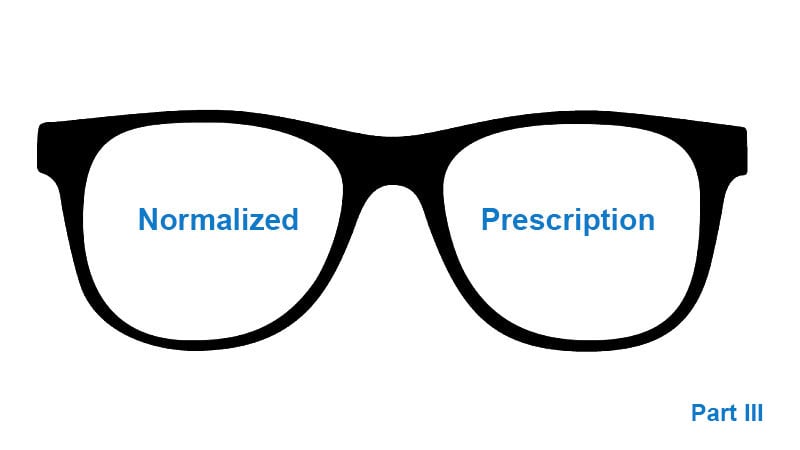
Hey, [s2Get user_field=”first_name” /]. We’re rolling right along!
Today is about the normalized prescription. I hope you have it already!
Along with the importance of starting off fresh (not wearing your previous, higher prescription on the same day), let’s look at some other good habits today.
Before we get to that, a quick bit of musing about perspective.
I’m a big introvert. Anything more than a few hours of people exposure on any given day, and I’m pretty much exhausted. I’ve picked up a lot of negative habits over the years, as a bit of a side effect of that personality type. (and not knowing that introvert is a thing, being hard on myself for being less sociable or outgoing than others)
One of the side effects of getting so deep into eyesight health has been lots of exposure to other, self-awareness and health related experts. Very helpful stuff.
And while I won’t stray too far from the path of discussing eyesight here, just a few relevant, related observations here:
How you verbalize things, even in your thoughts, affects your mood and outlook.
As a very easy example, I try to use the positive way of phrasing as much as possible. Instead of saying, “it rarely sucks to read these sessions”, you might say “it’s almost always brilliant and amazing to read these sessions”.
Very similar meaning, but the expression by a negative person, vs. by a positive person.
When I first got into these kind of habits, I thought they were silly. But since I got advice from people I hugely respect, people who always radiate a positive and happy persona, I decided to give it a shot.
And it turns out, it does affect me, and those I talk to. If there is a way of phrasing things positively, try to go for it.
You’ll get more sensitive to it over time. You’ll actually start to notice how jarring it is when people refer to something they own as “crap” or “shit”, even when they aren’t actually referring to things in an expressed negative way.
Why that, here?
Because how and when you wear glasses, and how you approach the experience, strongly affects the outcome. It’s one of the reasons I am less than fond of eye exercises. (see what I did there?)
Eye exercises aren’t fun. They aren’t habit-forming-friendly.
Likewise, it’s very, very easy to look at normalized as “less clear” or a “punishment” (of sorts), or a “necessary evil”. You might wear your full minus and then put on the normalized and think “gee, this sucks compared to my full prescription”.
On the other hand, if you follow my suggestions, you go from blur to normalized, and you see that you actually get a really good diopter bubble, and focus distance. You look at your eye chart and realize that, hey, you really can see pretty decently even with a lower prescription!
Here’s something weird:
Your brain literally, locks down if you start with something less than positive. I’ve seen it time and time again, and I’ve learned to first deal with clients attitudes, before going into the mechanics of prescriptions and habits.
Some people would just not improve at all, though all the technical aspects were the same. The only difference was their attitude, and small details of how they would approach prescription changes.
On the other hand, if you do as I recommend, you’ll never even know of the perils you avoided. (look at that sentence, how much that could be worded more positively)
But, let’s look at tangibles:
Action Items
Start the normalized wear off slowly.
Trend towards using differential, close-up, no glasses, at least long enough to fully appreciate the normalized “catching you”, giving you back lots of good distance vision. Don’t go as far as depriving yourself excessively, or doing anything dangerous (no driving without glasses!)
But just ever so slightly, bias your brain to *want* that normalized.
And also, start looking at your eye chart, and keep notes of changes. Take a look at this story in the blog, too: http://endmyopia.org/is-it-possible-2050-to-2015-vision-in-3-weeks/
Note there, Kim’s change in Snellen results with the new normalized, over the space of a few weeks. Neat, yea?
That’s what you’ll experience, too.
This will be active focus, as you already learned for close-up, but simply now also applied at a distance. You are starting to stretch your legs (eye-legs), getting back control over the visual range that optometry had put in a little box before. You are starting to fully appreciate the entire range of your vision, close-up as well as distance, and feeling around the edges of how far you can take it.
Liberating, yes?
This is what proper prescription use can do for you. The tools aren’t inherently good or evil. You can use glasses to mitigate an unnatural close-up lifestyle, and maintain good distance vision. You can use glasses to reverse myopia. It’s all just a matter of how you apply the tools.
We’ll keep going on all this, at a relaxing pace. Remember, habits. Feel free to explore, but also bear in mind the habit building. Make little calendar reminders if need be. Check that eye chart. Drop a note in your log. Keep track so you can fully appreciate improvements.
And let me know how you’re doing, in the forum!
Cheers,
– Jake
Session: Audio Track
pending …
Session: Video Stream
pending …
